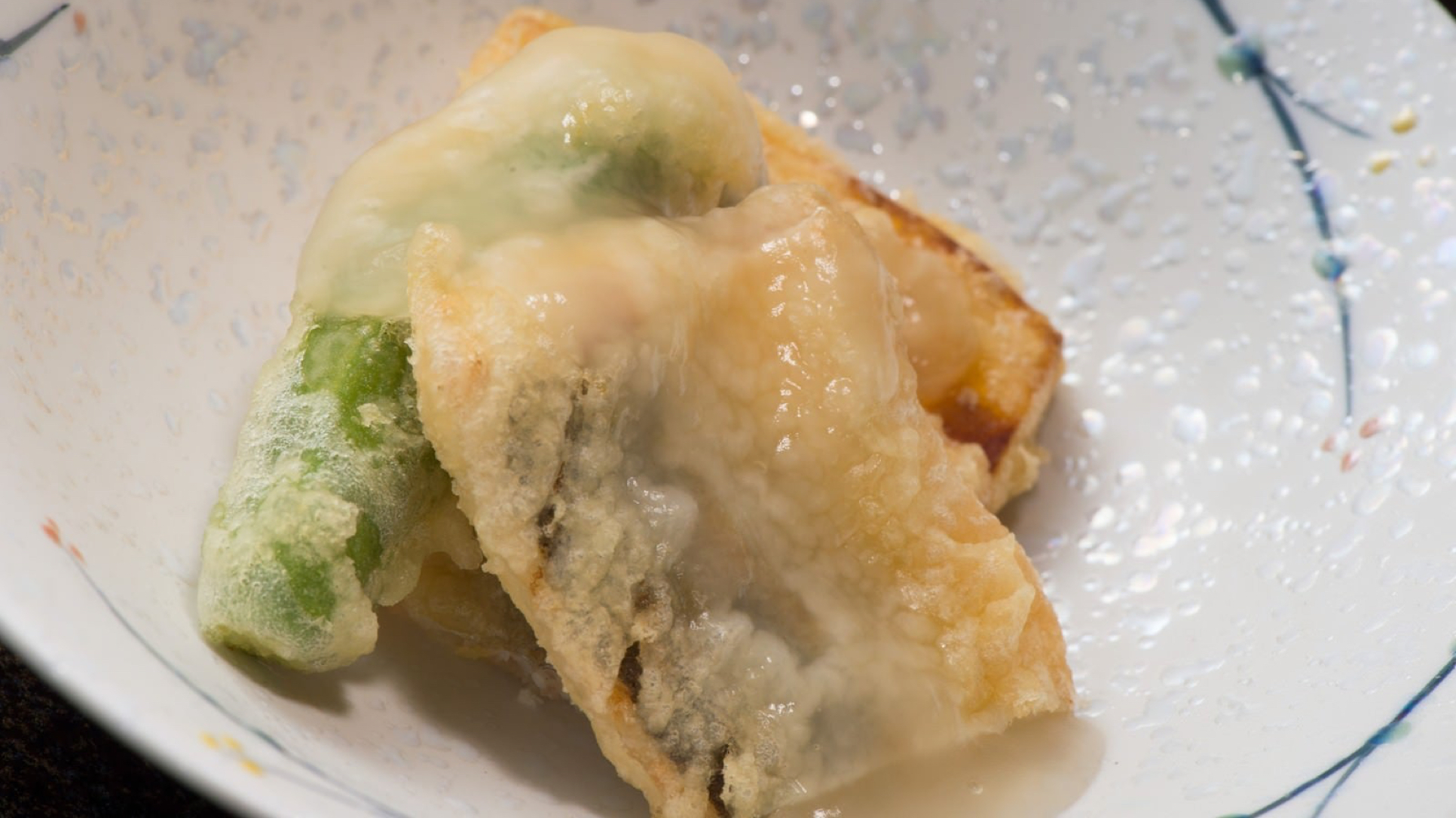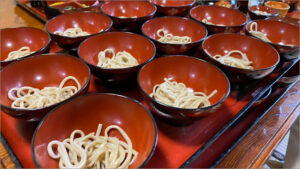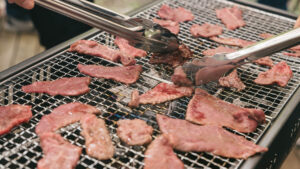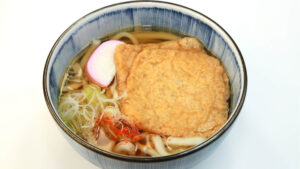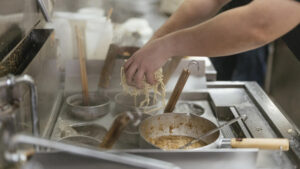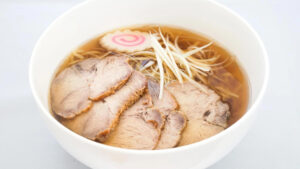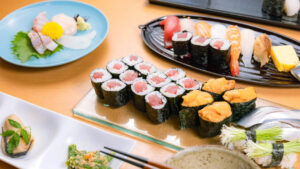Tempura is one of the most iconic and traditional dishes in Japanese cuisine. Shrimp, vegetables, and other ingredients are coated in a light batter and deep-fried to a crisp, creating a delightful texture that’s loved not only by the Japanese but by people all around the world.
But what makes tempura so special?
In this article, we’ll explore the history of tempura, tips for making the perfect batter, popular ingredients, proper ways to enjoy it, and even how to cook tempura at home.
Whether you’re planning to try authentic tempura while traveling in Japan or want to recreate it in your own kitchen, this guide is sure to help you appreciate the beauty of this classic dish.
Contents
- 1 What Is Tempura? – A Signature of Japanese Deep-Fried Cuisine
- 2 The Secret of Tempura Batter – Why It’s So Light and Crispy
- 3 Popular Tempura Ingredients – Treasures from the Sea and the Land
- 4 How to Enjoy and Eat Tempura
- 5 Try Making Tempura at Home! A Beginner’s Guide
- 6 Bring the Delight of Tempura Closer to Your Life
What Is Tempura? – A Signature of Japanese Deep-Fried Cuisine
Tempura is one of Japan’s most iconic traditional deep-fried dishes. With seafood and vegetables wrapped in light, crispy batter, it offers a refined presentation and flavor that captivates both the eyes and the palate. It’s a favorite not only among Japanese people, but also among visitors from around the world. Featuring seasonal ingredients and cooking methods that highlight the natural flavor of the food, tempura embodies the Japanese sense of beauty and culinary culture.
Interestingly, tempura has roots in a foreign cooking technique that evolved uniquely in Japan. In this section, we’ll explore how tempura developed from its origin to the form we know today.
The Origins and History of Tempura
Tempura’s Deep-Fried Roots from Portugal
In the 16th century, during Japan’s Warring States period, Portuguese missionaries arrived in Japan. Among the dishes they introduced was a type of fried food called peixinhos da horta, which is considered the prototype of modern tempura. At that time, deep-frying with oil was not common in Japanese cuisine, so the technique of coating ingredients with batter and frying them was quite novel.
This dish, which involved frying vegetables or fish in batter, closely resembles today’s tempura. Some theories even suggest that the word “tempura” comes from the Portuguese word tempero, meaning “seasoning.”
Becoming a Popular Food in the Edo Period
Tempura as we know it today became widespread during the Edo period (1603–1868). In Edo (modern-day Tokyo), tempura was sold from street stalls and became a beloved form of fast food for the common people. With access to fresh seafood, ingredients like shrimp and white fish (such as kisu) were commonly used.
This street-food style—serving freshly fried items on the spot—was appreciated for its convenience and delicious aroma, and it quickly became part of daily life in Edo.
Tempura Today: A Staple of Washoku (Japanese Cuisine)
In modern times, tempura is enjoyed in many settings—from casual home-cooked meals to high-end traditional restaurants. Especially in tempura specialty restaurants, the live experience of watching a chef fry items right in front of you has become very popular.
Tempura has also gained recognition around the world. It’s a staple menu item in Japanese restaurants overseas, and its light, crispy texture and focus on natural ingredients make it appealing to health-conscious diners. Tempura continues to play a key role in the global popularity of Japanese cuisine.
How Tempura Differs from Other Fried Foods
At first glance, tempura may look similar to other types of fried food. However, its preparation and flavor reflect a uniquely Japanese sense of delicacy and aesthetics. In this section, we’ll compare tempura with other popular fried dishes to better understand what makes it special.
Light and Crispy Batter – The Signature Texture
Tempura is most recognized for its thin, light, and crispy batter. It’s made using only flour, egg, and cold water, and mixed gently to prevent the formation of gluten. This technique results in a coating that doesn’t absorb too much oil, making the texture light and non-greasy.
Freshly fried tempura should be crisp on the outside and retain the texture of the ingredient inside. The batter should never be too thick—its role is to enhance, not overpower—which is part of what makes tempura so visually and texturally refined.
A Cooking Method That Enhances Natural Flavor
Tempura isn’t just about texture. It’s also an excellent way to highlight the natural flavor of the ingredients. Seasonal vegetables and fresh seafood are lightly coated and fried in a way that preserves their aroma, sweetness, and texture.
The seasoning is minimal. Tempura is typically served with a simple dipping sauce called tentsuyu (made from dashi broth), or just a pinch of salt. Rather than using bold sauces, tempura reflects a culinary philosophy that values the ingredient itself.
Comparison with Frying and Karaage
Japan has many other popular fried foods besides tempura, such as furai (breaded and deep-fried items like tonkatsu or shrimp fry) and karaage (Japanese-style fried chicken). Each has its own method and flavor profile:
- Fry (furai): Coated in breadcrumbs, resulting in a thicker, crunchier crust. Often served with sauces like tonkatsu sauce.
- Karaage: Marinated meat is deep-fried, making it juicy and richly flavored. Garlic and soy-based seasonings are common.
- Tempura: Lightly coated without seasoning, focusing on the natural taste and aroma of the ingredient.
In this way, tempura can be described as the fried dish that most honors the pure flavor of the ingredient itself.
Tempura’s Place in Japanese Culture
Tempura is more than just a dish—it’s a cultural expression of Japan’s seasons and aesthetic values. From ingredient selection to presentation and dining setting, tempura reflects the Japanese spirit of appreciating food with all the senses.
A Dish That Celebrates the Seasons
Japan has four distinct seasons, and tempura is cherished as a way to enjoy the ingredients of each. In spring, mountain vegetables like tara no me and fuki no tō; in summer, eggplant and shishitō peppers; in autumn, maitake mushrooms and sweet potatoes; and in winter, oysters and lily bulbs are popular choices.
This concept of “tasting the season” is deeply rooted in Japanese cuisine, and tempura is a perfect representation of that philosophy.
Served in Kaiseki and Specialty Restaurants
Tempura plays an important role in formal kaiseki meals, where a skilled chef fries seasonal ingredients at just the right moment and serves them as part of a carefully curated course. The result is a dish that is not only delicious but also artful.
In tempura specialty restaurants, it’s common to sit at a counter and enjoy each piece of tempura as it’s fried to order. Watching the chef’s precise movements and attention to timing, batter, and oil temperature is a unique culinary experience found only in Japan.
A Familiar Part of Home Cooking
At the same time, tempura is a beloved part of everyday home cooking in Japan. Families often enjoy frying seasonal vegetables together, and tempura frequently appears in lunchboxes or as a topping for soba noodles.
One popular tradition is placing shrimp tempura on New Year’s Eve soba noodles (toshikoshi soba), or packing assorted tempura in bento boxes for school sports days. These familiar scenes bring a sense of nostalgia and seasonal charm, making tempura a warm and comforting presence in Japanese households.
The Secret of Tempura Batter – Why It’s So Light and Crispy
One of the most captivating features of tempura is its light and crispy batter. This unique texture is created through the use of simple ingredients combined with precise technique. In this section, we’ll explore the secrets behind achieving that perfect crunch.
Basic Ingredients and Their Ratio
Tempura batter is made from surprisingly simple ingredients, but the way they are combined and handled greatly affects the final texture. Understanding the basics is essential to creating the ideal batter.
The Golden Ratio: Flour, Egg, and Cold Water
The three core ingredients of tempura batter are flour, egg, and cold water. Together, they create a light, airy coating that crisps beautifully when fried.
- Flour: Cake flour (low in gluten) is commonly used in Japan. It helps create a thin, delicate coating that doesn’t overpower the flavor of the ingredients.
- Egg: Adds a subtle richness and viscosity, and gives the batter a pleasant golden color when fried.
- Cold Water: Prevents gluten development, keeping the batter light and reducing oil absorption.
A typical ratio is about 100g of flour, 1 egg, and 180ml of cold water.
How to Minimize Gluten for a Light Texture
To keep tempura batter light and crispy, it’s crucial not to overmix. When flour is combined with water, gluten develops—and too much gluten makes the batter heavy and chewy.
Use chopsticks or a fork to gently stir the batter just around 10 times. It’s okay if there are small lumps—it’s even preferred! This rough mixing technique helps create the signature airy crispness after frying.
Also, avoid making the batter in advance. Prepare it right before frying to keep it cold and fresh.
The Role of Dusting Flour (Uchiko)
Before dipping ingredients into the batter, it’s common to lightly coat them with flour in a process called uchiko (dusting flour). This is an important step to help the batter adhere evenly.
Dusting flour allows the batter to cling more firmly, prevents it from peeling off during frying, and helps maintain a consistent coating thickness. It also reduces splattering caused by moisture in vegetables or seafood.
Use a small amount of flour and lightly shake off the excess before dipping into the batter.
Oil Selection and Temperature Control Tips
To fry delicious tempura, it’s not just the batter that matters—choosing the right oil and managing the temperature are equally important. Here, we’ll explain the key points for bringing out the best in each ingredient.
Choosing the Right Oil: Sesame, Salad, or Blended?
In Japan, various oils are used for frying tempura, including sesame oil, salad oil (such as canola or soybean), or blends of both. The type of oil you choose can greatly affect the aroma, flavor, and texture of the finished dish.
- Sesame oil (white/light sesame oil): Mild in aroma and often used by professional chefs. It produces a light, clean finish.
- Fragrant sesame oil: Adds a toasted, nutty flavor. This style is especially popular in western Japan (Kansai region).
- Salad oil (canola, soybean, etc.): Neutral and affordable—ideal for home cooking.
- Blended oil: A 7:3 or 5:5 mix of sesame and salad oil can balance lightness with aroma.
By adjusting the oil to match your dish and personal taste, you can enjoy a more nuanced tempura experience.
Ideal Temperatures by Ingredient
Temperature control is crucial in deep-frying. If the oil is too hot, ingredients burn; too cold, and the result becomes soggy. Here are some general temperature guidelines by ingredient type:
- Vegetables (eggplant, bell pepper, sweet potato): 160–170°C (320–338°F)
→ Cooked slowly to draw out sweetness and moisture. - Seafood (shrimp, white fish, squid): 170–180°C (338–356°F)
→ Crisp outside, juicy inside. - Delicate leaves (shiso, nori): 150–160°C (302–320°F)
→ Fry quickly at lower temperatures to avoid burning the batter.
As a simple trick, insert a wooden chopstick into the oil: fine bubbles mean ~160°C, while larger, vigorous bubbles indicate ~180°C.
How to Avoid Overcooking and Burning
Even high-quality ingredients can become unpleasant if over-fried. Here are key tips to avoid common mistakes:
- Watch the color: Remove ingredients when they turn a light golden brown—don’t wait for deep browning.
- Listen to the sound: The “crackling” sound becomes quieter when moisture in the batter has cooked off—this signals it’s ready.
- Don’t overcrowd the pot: Too many items at once lowers the oil temperature, leading to uneven frying and sogginess.
After frying, drain thoroughly on a wire rack or paper towel. Removing excess oil helps maintain the crispness, even after some time has passed.
Techniques That Affect the Final Result
The deliciousness of tempura depends heavily on small techniques. From how the batter is applied, to the timing of frying, and how the excess oil is removed—mastering these steps brings your tempura closer to restaurant quality. Here are some key tips to improve your results.
Controlling Batter Thickness and Dropping Technique
The ideal batter is neither too thick nor too thin. If it’s too thick, it will overpower the flavor of the ingredient and feel heavy. If too thin, the coating may peel off during frying.
- Lightly dust the ingredients with flour before dipping them in the batter.
- After dipping, gently shake off excess batter to avoid clumping.
- When placing the item in the oil, lower it gently and let it slide in slowly. Dropping it too quickly may cause the batter to scatter or the shape to break.
For long, delicate ingredients like shrimp, hold one end and gently curve it into the oil to create a graceful shape.
Using Bubble Behavior to Judge Doneness
If you’re not confident in timing the frying process, observing the bubbles around the ingredients can help determine doneness:
- Start of frying: Large, vigorous bubbles = high moisture content
- Middle stage: Smaller bubbles, quieter sound = moisture decreasing
- End stage: Very small bubbles, reduced popping sounds = frying is complete
To avoid overcooking, also pay attention to the aroma and sound—a subtle shift in scent or noise often signals it’s time to remove the item from the oil.
How to Drain Excess Oil Properly
Draining excess oil immediately after frying prevents sogginess and helps maintain crispiness for longer—even after cooling down.
- Place fried items on a wire rack or tray right after frying.
- Lightly press the bottom with paper towels to absorb excess oil.
- Leaning items at an angle can help oil drip off naturally without flattening the batter.
For best results, consider the frying order: start with high-moisture vegetables, then seafood, and finish with aromatic ingredients like shiso or red ginger. This prevents flavor transfer and keeps your oil clean and clear.
Popular Tempura Ingredients – Treasures from the Sea and the Land
One of the most appealing aspects of tempura is the wide variety of ingredients it features. From seafood and vegetables to wild mountain plants, the types of ingredients vary by season and region. In this section, we’ll introduce some of the most beloved tempura items, divided into seafood and land-based categories.
Classic Seafood Ingredients
Fresh seafood pairs perfectly with tempura. The batter locks in the umami, while the interior remains soft and juicy. These seafood items are frequently served in tempura restaurants and home kitchens across Japan.
Shrimp – The King of Tempura
Shrimp tempura is the most iconic and widely recognized form of tempura. With its straight shape, beautiful golden color, and plump texture, it’s a favorite for both taste and presentation. Varieties like kuruma ebi (Japanese tiger prawn) and black tiger shrimp are commonly used.
Skilled chefs use a technique that involves slicing the back of the shrimp to keep it straight while frying. The batter adheres well, creating a perfect balance of crispness and juiciness. Shrimp tempura is versatile and delicious whether dipped in tentsuyu sauce or simply sprinkled with salt.
Squid and White Fish – Mild Flavor and Tender Texture
Squid (ika) is known for its sweet flavor and soft texture that intensifies the more you chew. Coating it in batter helps retain its shape and creates a fluffy bite. Popular types include surume ika and yari ika.
White fish such as cod, sillago (kisu), and flathead (megocchi) offer a mild but refined flavor. When fried in a light batter, the result is delicate and flavorful. These fish have few bones, making them easy and enjoyable to eat.
These seafood items are especially delicious with a sprinkle of salt, which enhances their natural flavors.
Scallops and Oysters – Seasonal Luxuries
Scallops (hotate) have a rich sweetness and soft texture. When prepared as tempura, they remain juicy on the inside while the outside becomes crisp and golden. Depending on the size and thickness, careful frying is required to achieve the perfect doneness.
Oysters (kaki) are a popular winter delicacy. Deep-frying concentrates their briny umami and complements it with a toasty batter. Large oysters from Hiroshima and other regions are especially prized for their flavor and texture.
Both scallops and oysters are seasonal treats that many Japanese people look forward to each year. They represent the luxury and depth of seasonal tempura ingredients.
Recommended Vegetable Tempura Ingredients
Tempura isn’t just about seafood—it’s also a beloved way to highlight the natural flavors of vegetables. Vegetable tempura brings out the sweetness, aroma, and vibrant colors of seasonal produce, offering a light and healthy option. Here are some of the most popular and classic vegetable ingredients used in tempura.
Sweet Vegetables: Sweet Potato and Pumpkin
Sweet potato and pumpkin are well-loved for their natural sweetness and soft, starchy texture that shine through when deep-fried. The crispy exterior and moist, fluffy interior make them especially satisfying.
- Sweet Potato: Thin slices allow for even cooking and help draw out the subtle sweetness of the potato.
- Pumpkin: Frying with the skin on enhances the dish’s visual appeal, adding vibrant color and texture.
These ingredients are favorites among both children and adults. Sprinkling them with a little salt brings out their natural sweetness even more.
Colorful and Textural: Eggplant and Shishito Peppers
Eggplant has excellent oil absorption, resulting in a melt-in-your-mouth texture and a rich purple hue when fried. Cutting it in half or adding decorative slits before frying enhances its appearance.
Shishito peppers are small, slender Japanese peppers with a mild bitterness and a crisp exterior. Their juicy interior and crunchy coating create a delightful contrast.
Both ingredients are essential for adding color and texture to any tempura platter.
Fragrant Mushrooms: Maitake and Shiitake
Mushrooms are ideal for tempura because frying locks in their rich aroma and umami. Maitake and shiitake are two of the most popular varieties.
- Maitake: Frying the clusters whole preserves their natural shape, giving a crispy texture along the grain and a dramatic presentation.
- Shiitake: Using the thick cap provides a juicy bite and deep, earthy flavor. A light sprinkle of salt on the underside enhances the taste.
These mushrooms add a distinctly autumnal flair and are gaining popularity even outside of Japan as classic ingredients in traditional Japanese cuisine.
Unique & Regional Tempura Delights
Beyond classic ingredients like shrimp and vegetables, Japan is home to a wide range of unique tempura items. From beloved local favorites to seasonal wild plants, here are some regional and unconventional tempura ingredients that offer a truly Japanese culinary experience.
Red Pickled Ginger & Chikuwa (Kansai-style)
In the Kansai region, two popular and distinct tempura items are beni shoga (red pickled ginger) and chikuwa (fish paste tubes).
- Red Pickled Ginger Tempura: Thin slices of pickled ginger are battered and deep-fried, resulting in a zesty, tangy bite with a vibrant red color. It’s often served with udon noodles or okonomiyaki.
- Chikuwa Tempura: Made by frying whole chikuwa sticks (tubes of fish paste), this tempura has a crispy exterior and a soft, springy inside. It’s a staple in casual soba shops and bento boxes.
These ingredients are considered “B-grade gourmet” and loved for their simplicity and bold flavor.
Shiso Rolls & Fried Perilla Leaves
Shiso (perilla leaves) bring a uniquely Japanese aroma to tempura dishes.
- Shiso Rolls: Ingredients like ume paste, miso, or minced meat are wrapped in shiso leaves, coated in batter, and fried. The result is a dish bursting with fragrance and a refreshing aftertaste.
- Fried Perilla Leaves: Whole shiso leaves are deep-fried for a crisp, aromatic bite. The light, crispy texture and fresh scent make them a favorite vegetarian option.
These herbaceous tempura items offer a delightful contrast to heavier meat or seafood ingredients.
Mountain Vegetables (Sansai): Fuki no Tō, Tara no Me, and More
In spring, tempura made from sansai (wild mountain vegetables) appears on menus across Japan. These seasonal delicacies are foraged from the mountains and evoke a deep sense of seasonal change.
- Fuki no Tō (Butterbur Sprouts): Known for their subtle bitterness and floral aroma, they are a refined taste often enjoyed by adults.
- Tara no Me (Aralia Sprouts): Slightly sweet and tender, these spring buds have a fluffy texture when fried.
- Other regional sansai include kogomi (ostrich fern), zenmai (Japanese royal fern), and udo (Japanese spikenard), depending on the area.
These mountain vegetables are only available for a short time in spring, making them a symbolic way to “taste the season” in traditional Japanese cuisine.
How to Enjoy and Eat Tempura
The way you eat tempura can greatly influence how it tastes. Whether dipped in traditional tentsuyu sauce or sprinkled with salt to highlight the ingredients, each method brings out different flavors. This section introduces seasoning options and condiments that enhance the experience of tempura.
Sauces, Salts, and Condiments
Tempura can be enjoyed in many ways. While freshly fried pieces taste delicious on their own, using tentsuyu sauce, various salts, or condiments can elevate the flavors even further.
Tentsuyu Sauce: How to Make and Use It
Tentsuyu is a dipping sauce made from dashi, soy sauce, and mirin. Its mild sweet-salty flavor complements the crispness of the tempura coating.
Basic Tentsuyu Recipe (Serves 2):
- Dashi: 100 ml
- Soy sauce: 25 ml
- Mirin: 25 ml
Simply bring the ingredients to a gentle boil in a saucepan. Adding grated daikon radish creates a lighter, more refreshing flavor. When eating, lightly dip the tempura for a brief moment to avoid over-soaking the crispy coating.
Matcha Salt & Yuzu Salt: Enhancing Ingredients
If you want to appreciate the natural taste of each ingredient, eating tempura with salt is highly recommended. Many specialty tempura restaurants offer a selection of flavored salts.
- Matcha Salt: The subtle bitterness and aroma of green tea pairs beautifully with shrimp or white fish.
- Yuzu Salt: A refreshing citrus-salt blend that enhances vegetable or mushroom tempura.
- Rock Salt or Seaweed Salt: Mild and elegant in flavor, these are ideal for savoring the original taste of the ingredients.
Sprinkle a small amount of salt directly on the tempura. Be careful not to overdo it, as it can become overly salty.
Grated Daikon and Ginger as Condiments
Grated daikon radish and grated ginger are commonly served with tentsuyu sauce. These condiments help cut through the oiliness of tempura and refresh your palate.
- Grated Daikon: Adds texture and a cooling effect when mixed into the sauce, resulting in a healthier and more refreshing bite.
- Grated Ginger: A small amount gives a spicy kick, making it especially suitable for seafood tempura.
With these simple additions, you can enjoy a variety of flavor profiles using the same ingredients—a testament to the depth and versatility of tempura cuisine.
Combining Tempura with Rice and Noodles
Tempura isn’t just enjoyed on its own—it becomes a satisfying meal when paired with rice or noodles. Below are some of the most popular and beloved combinations in Japanese cuisine.
Tendon (Tempura Rice Bowl): A Perfect Harmony of Sauce and Crispiness
Tendon is a classic dish where freshly fried tempura is placed on a bed of rice and topped with a sweet and savory sauce. The contrast between the crispy tempura and the flavorful rice soaked with sauce is irresistible and widely loved in Japan.
- The sauce is typically made from soy sauce, mirin, and sugar, and pairs well with shrimp, pumpkin, green beans, and more.
- Served in a bowl, it’s convenient and satisfying—perfect for lunch or takeout.
- Many people consider tendon to be the easiest and most accessible way to enjoy tempura.
Ten-zaru Soba/Udon: A Refreshing Summer Pairing
Ten-zaru soba or udon is an ideal summer meal, combining cold noodles with a side of tempura.
- The rich, savory flavor of the tempura balances well with the refreshing taste of chilled noodles.
- The noodles are dipped in a cold soy-based sauce, while the tempura is usually enjoyed with salt or tentsuyu.
- This style is widely served at soba specialty shops and tourist spots, especially during the summer season.
Teishoku Set Meals: A Traditional Dining Style
Tempura teishoku (set meals) include tempura served with rice, miso soup, and pickles. This style is popular at traditional Japanese restaurants and inns.
- Some establishments serve tempura piece by piece, allowing diners to savor each freshly fried item.
- Seafood and vegetables are arranged in a well-balanced and visually pleasing presentation.
- This dining style reflects the Japanese “ichiju-sansai” (one soup, three dishes) approach—offering variety and harmony in one meal.
Experiencing Tempura at Specialty Restaurants
Tempura at home is delightful, but dining at a specialty tempura restaurant offers a whole new level of enjoyment. If you’re visiting Japan, don’t miss the luxurious experience of freshly fried tempura prepared right before your eyes by skilled chefs.
Enjoying Freshly Fried Tempura at the Counter
At many tempura specialty restaurants, it’s common to sit at a counter where chefs fry each ingredient right in front of you.
- Each piece is served immediately after frying, allowing you to enjoy it at its best timing and temperature.
- The sizzling sound, the aroma of the oil, and the chef’s skillful movements create a multi-sensory, live cooking performance.
- This immersive experience is not just about food—it’s also a window into Japan’s hospitality culture.
Luxury Tempura Courses with Seasonal Delicacies
High-end tempura restaurants offer multi-course meals featuring seasonal ingredients. Each item—shrimp, white fish, vegetables, mushrooms—is prepared with precise temperature and timing, and served in the ideal order.
- The course may start with an appetizer, followed by multiple tempura items, a palate cleanser, rice, soup, and dessert.
- Menus change based on the season and location, making each visit a fresh culinary discovery.
- While more expensive, the refined craftsmanship and ambiance create an unforgettable, once-in-a-lifetime experience.
Local Tempura Experiences in Tourist Destinations
In tourist destinations such as Kyoto, Kamakura, or Asakusa, you can enjoy unique regional tempura made with local ingredients and cultural flair.
- Examples include yuba (tofu skin) or namafu (wheat gluten) in Kyoto, and ago (flying fish) in Kyushu.
- Many restaurants are located in charming traditional buildings or riverside terraces, enhancing the overall travel experience.
Try Making Tempura at Home! A Beginner’s Guide
Tempura isn’t just something to enjoy at restaurants—it’s actually easier to make at home than you might think. With the right batter and cooking time, even beginners can achieve that signature light and crispy texture. This section introduces the basic tools and steps for making delicious tempura in your own kitchen.
Essential Tools and Ingredients
Let’s start by gathering the tools and ingredients you’ll need. The good news is that you can make tempura with items you likely already have at home.
List of Basic Cooking Tools
- Deep Frying Pot: A pot with depth (20–24 cm in diameter is ideal). Stainless steel or cast iron is recommended.
- Thermometer (optional): Useful for measuring oil temperature. If unavailable, you can judge by the bubbles or using chopsticks.
- Long Chopsticks or Tongs: For placing in and removing items from the oil safely.
- Tray and Rack: To drain excess oil. You can also use a plate lined with paper towels as an alternative.
- Bowl and Whisk (or chopsticks): For mixing the batter.
- Newspaper or paper towels can be used to protect the kitchen from oil splatter and ease cleanup.
Recommended Ingredient Set for Beginners
Here’s a set of easy-to-handle, beginner-friendly ingredients:
- Seafood: Peeled shrimp, white fish (such as cod or whiting)
- Vegetables: Sweet potato, pumpkin, eggplant, bell pepper, shishito pepper, shiitake mushrooms
- Others: Chikuwa (fish cake), shiso leaf, pickled red ginger (beni shoga, optional)
All of these are easy to prep, cook quickly, and are widely available in supermarkets.
Using Store-Bought Tempura Batter Mix
Tempura batter is typically made from flour, egg, and cold water, but beginners can benefit from using ready-made tempura flour mix.
- These mixes have the perfect ratio of ingredients—just add water.
- Some include baking powder or powdered egg yolk to ensure a light and crispy finish.
- Widely available at most supermarkets and Asian grocery stores.
If you want to minimize effort or reduce the chance of failure, pre-mixed batter is a great starting point. Once you’re confident, you can try making your own batter from scratch.
Steps and Tips for Cooking Tempura
Tempura might seem tricky at first, but once you learn the basic process and key points, you can enjoy making it at home. This section walks you through the entire process—from making the batter to frying and plating—with beginner-friendly advice.
From Batter to Frying: Step-by-Step
- Prep the ingredients: Cut vegetables and seafood into bite-sized pieces and pat them dry thoroughly to prevent oil splatter.
- Make the batter: Mix 1 egg into 100 ml of cold water, then gently fold in about 100 g of flour. Stir just 10 times—don’t overmix! It’s fine if a few lumps remain.
- Heat the oil: Pour oil into a deep pot and heat to 160–180°C (320–356°F). To check: gentle bubbles at 160°C, vigorous bubbling at 180°C.
- Coat and fry: Dust ingredients lightly with flour, dip into the batter, then gently slide them into the oil to avoid splashing or breaking the shape.
- Drain and serve: Once golden brown, remove from the oil and place on a rack or paper towels. Serve while hot for the best texture.
Frying Time Guidelines
The key to crispy tempura is short frying time. Cooking time varies by ingredient, but here are general guidelines:
- Root vegetables (e.g., sweet potato, pumpkin): 1.5–2 minutes
- Leafy greens, shiso: 30 seconds – 1 minute
- Seafood (e.g., shrimp, white fish): 1–1.5 minutes
- Mushrooms (e.g., shiitake, maitake): 1–2 minutes
Watch for the sound of bubbling to fade and the color to turn golden brown. Overcooking can ruin the texture, so listen and look carefully while frying.
How to Prevent Oil Splatter and Burns
- Dry ingredients thoroughly: Excess moisture causes oil to splatter dangerously.
- Gently place items in the oil: Avoid dropping food quickly into the pot to reduce risk of oil splash and batter coming off.
- Keep a safe distance: Don’t lean over the pot while frying.
- Use long chopsticks or tongs: Helps keep your hands safely away from the hot oil.
If you have children, make sure the cooking area is out of their reach. Most importantly, never leave the fryer unattended while cooking—safety always comes first.
Cleanup and Oil Disposal After Cooking
After enjoying homemade tempura, proper cleanup is just as important. Handling used oil and washing utensils correctly is essential for both safety and hygiene.
How to Store or Dispose of Used Oil
- Storing oil for reuse: Used oil can be reused 2–3 times if handled properly. Once the oil cools, strain it using a fine mesh or paper towel to remove debris, then transfer it to a heatproof, airtight container (like an oil pot). Store in a cool, dark place away from direct sunlight.
- Disposing of oil: Soak the oil into newspaper or paper towels and discard it as burnable trash. Never pour oil down the drain—it can clog pipes and harm the environment.
- Solidifying agents and oil-absorbing pads are available at supermarkets and 100-yen shops, making oil disposal more convenient.
How to Clean the Frying Pot and Utensils
- Wipe excess oil: Use paper towels to remove any remaining oil inside the pot before washing.
- Use hot water before detergent: If there’s heavy grease or burnt residue, pour hot water into the pot and let it sit—it will make cleaning easier.
- Wash with sponge and mild detergent: Use a soft sponge and dish soap to gently clean the metal pot and rack. Avoid harsh scrubbing to prevent damaging nonstick coatings.
- Dry thoroughly: Make sure to dry all utensils completely to prevent rust before putting them away.
Storage Tips for Next Time
- Use an oil pot: A straining oil pot allows you to quickly reuse clean oil next time. Ideally, replace oil after using it three times or less.
- Keep track of oil usage: Note the number of uses and the last used date on the container to avoid using old oil unknowingly.
- Organize your tempura tools: Store all your tempura utensils together in one place to make prep quicker and easier next time.
With just a few smart habits, homemade tempura can go from being a “special treat” to an easy everyday favorite.
Bring the Delight of Tempura Closer to Your Life
Tempura is more than just deep-fried food—it’s a delicate Japanese culinary art that enhances the natural flavors of each ingredient. The crispy coating, seasonal ingredients, fragrant condiments, and dipping sauces all reflect Japan’s refined sense of food aesthetics.
Whether you’re savoring freshly fried tempura at a specialty restaurant or casually trying it at home, both approaches offer their own charm. We hope this article helps inspire your own unique tempura experience.
With just one bite, enjoy the rich aroma and gentle taste—why not bring a touch of Japan’s culinary scenery to your table through tempura?
